Celebrating signing the Memorandum of Understanding (from left): Save the Redwoods League President and CEO Sam Hodder, Redwoods National Park Superintendent Steve Mietz, Yurok Tribal Chairman Joseph L. James and California State Parks District Superintendent Victor Bjelajac. | All photos by Andrew Goff except where noted.
###
On Tuesday morning, near the border of Redwood National and State Parks, a group of about a dozen people gathered at the former site of the Orick Sawmill, 125 mostly flat acres that, over the past decade, have been painstakingly restored to a semblance of their former natural state.
The folks gathered included representatives of Save the Redwoods League, the National Park Service, California State Parks and, perhaps most significantly, the Yurok Tribe.
This land, nestled between Prairie Creek, Redwood Creek and an expanse of forest that includes the world’s tallest trees, is known as ‘O Rew in the Yurok language, and it lies near the center of the Tribe’s ancestral territory.
The purpose of the gathering was to celebrate a landmark agreement to repatriate this property back to the Yurok Tribe and to enter a long-term co-management arrangement of the site, the details of which are explained in a press release below.
Shortly after arriving, the group walked across the former mill site toward the forest on an old, dirt logging road to get a better vantage of the property, which, over the next couple of years, will be transformed into a new southern gateway to the park, complete with a visitor and cultural center along with a reconstructed traditional Yurok village, including plank houses and a sweat house.
The assorted luminaries on hand took turns speaking to the significance of the moment. Sam Hodder and Jessica Carter of Save the Redwoods League talked about the extensive environmental restoration work that has been done since their organization took ownership of the property from Green Diamond in 2013.
Rosie Clayburn, tribal historic preservation officer for the Yurok Tribe, said the new visitor center will highlight “the amazing restoration work” that’s been done onsite while also offering a place to house important cultural items that the Yurok Tribe has reacquired over the past couple of decades.
Yurok Tribal Chairman Joseph L. James.
Yurok Tribal Chairman Joseph L. James asked those in attendance to reflect on how they were feeling while standing in this place, surrounded by nature.
“There’s no better way of feeling,” James said. “Redwoods, the ferns, the alders — everything you see here today we used, and we still do. … traditional natural resources that we use every day, just to wake up, just to open our mind with what the Earth provides us. … This trail system here, being around all these redwoods here will open your mind and just feel the good vibe, the good medicine around this area.”
Yurok Tribal Councilmember Phillip Williams.
Then it was Phillip Williams’s turn. A member of the Yurok Tribal Council, Williams (pictured above) recalled working at the sawmill back in the 1990s.
“It was unsettling inside myself, watching the redwoods get cut up, but I’m working there because I had to provide for my family,” he said.
At the time, the Tribe had an adversarial relationship with the mill’s then-owner, Simpson Timber Company, with the Tribe longing to preserve the trees that were being cut down and converted into lumber.
“Once, I was disenfranchised from this place,” Williams said. “It wasn’t mine. I didn’t have any ownership. I never, ever had any hope of getting any ownership. And now with the partnership that you guys are having, I feel an ownership.”
He looked around that the people gathered there on the hill and then looked back down at the prairie where the mill used to stand. “And so, for me, it’s a big part inside of me that’s satisfied that I get to see this in my lifetime,” he said. “So it’s really, really — you know, it’s empowering.”
Looking north from the former mill site to the forest of alders and redwoods, where an extensive network of trails lead visitors through Redwood State and National Parks.
###
Below is a joint press release from the Yurok Tribe, Save the Redwoods and the National Park Service explaining more about the landmark agreement:
Orick, CA — [On Wednesday] the Yurok Tribe, Save the Redwoods League, National Park Service and California State Parks signed a landmark memorandum of understanding, a historic first step toward transferring ‘O Rew, a 125-acre ecologically and culturally important property, from Save the Redwoods League back to its original steward, the Yurok Tribe.
In addition, the agreement describes the four partners’ shared vision for long-term co-management of the site as a gateway for the visiting public to the adjacent Redwood National and State Parks (RNSP). This would be a first-ever cooperative arrangement for the National Park Service and California State Parks on tribe-owned land. The partners envision building a new visitor and cultural center and trails at ‘O Rew that will highlight the distinct histories and cultures of local tribes.
“On behalf of the Yurok people, I want to sincerely thank Save the Redwoods League for committing to repatriate this critical part of our homeland. We are also appreciative of Redwood National and State Parks’ participation in this truly one-of-a-kind partnership. Together, we are creating a new conservation model that recognizes the value of tribal land management,” said Joseph L. James, the Chairman of the Yurok Tribe.
“Today we acknowledge and celebrate the opportunity to return Indigenous guardianship to ‘O Rew and reimagine how millions of visitors from around the world experience the redwoods,” said Sam Hodder, president and CEO of Save the Redwoods League. “Today’s agreement starts the process of changing the narrative about how, by whom and for whom we steward natural lands. There’s a lot of important work to be done in the coming years to realize our shared vision. But the League and our partners are fully committed, and we’re honored to collaborate with the Yurok Tribe, National Park Service and California State Parks to create a new model of shared environmental and recreational stewardship.”
New Trail Access and Cultural Gateway to RNSP
The vision codified in today’s memorandum of understanding is for Save the Redwoods League to convey ‘O Rew to the Yurok Tribe in 2026, after the Redwoods Gateway and Prairie Creek Restoration project, currently in progress, is completed. Conveniently located off U.S. Highway 101 at the base of Bald Hills Road in Orick, CA, the site will become a southern gateway to Redwood National and State Parks. The ‘O Rew Redwoods Gateway will be the first co-management model whereby National Park Service and California State Parks will support visitation and stewardship on land owned by a Tribe.
Critical elements of the new recreational and cultural gateway will be built in 2025 prior to the transfer. These comprise more than one mile of accessible new trails, including a new segment of the California Coastal Trail, interpretive exhibits across the site and other visitor amenities. The new trails will connect to numerous existing trails in the parks, including direct access to one of the most popular old-growth redwood groves in the parks, Lady Bird Johnson Grove.
The agreement outlines that, after the transfer, the Yurok Tribe aims to construct a visitor center highlighting the distinct history and living culture of the Tribe and the extraordinary natural, cultural and recreational resources of the parks. The Yurok Tribe also plans to build a traditional village onsite, including plank houses and a sweat house.
“This is a first-of-its-kind arrangement, where Tribal land is co-stewarded with a national park as its gateway to millions of visitors.This action will deepen the relationship between Tribes and the National Park Service,” said Redwoods National Park Superintendent Steve Mietz. “The restoration efforts completed by the partners on this site link the large-scale watershed restoration upstream by the Redwoods Rising collaborative with downstream landowner-led efforts to restore the Redwood Creek Estuary, healing the land while healing the relationships among all the people who inhabit this magnificent forest.”
“This agreement further strengthens California State Parks’ relationship with the Yurok Tribe, and we welcome the opportunity to forge additional actions that support Indigenous land management with state, federal and nonprofit resources,” said Armando Quintero, director of California State Parks. “This historic agreement provides a pathway for the addition of Indigenous lands to the suite of values employed in co-managing and protecting Redwood National and State Parks lands for the enjoyment of public and Indigenous peoples in the region.”
About ‘O Rew
The 125-acre property — ‘O Rew in the Yurok language — encompasses a significant place for the Yurok people on Prairie Creek. Located near Orick in Northern California, ‘O Rew is roughly in the center of Yurok ancestral territory. During the mid-1800s, there was an attempt to forcibly remove Yurok people from their homeland, including ‘O Rew and nearby Owr-rekw, to expedite exploitation of the region’s natural resources, including old-growth coast redwood trees.
Save the Redwoods League purchased and conserved the site in 2013. Before that, for more than 50 years, it operated as a lumber mill and was referred to as the Orick Mill Site and Mill Site A. While the mill was in operation, large portions of the land were paved over, and much of the natural channel and floodplain of Prairie Creek was buried. For the last 10 years, the League has partnered with accomplished restoration experts, including the Yurok Tribe Construction Corporation and 3 Fisheries Department and California Trout, to undertake a full restoration of a critical stretch of Prairie Creek on the site for the benefit of federally listed coho salmon and steelhead.
As part of that effort, Yurok Tribe restoration crews built a new, nearly one-mile-long meandering stream channel with abundant features to support fish, two connected ponds and approximately 20 acres of floodplain habitat. More than 50,000 native plants, including grass-like slough sedge, black cottonwood and coast redwood trees, have been planted in specific locations on the banks of the creek, ponds and floodplain of the Redwood Creek tributary. Thousands of juvenile coho and chinook salmon and steelhead are already taking advantage of the new habitat. Multiple wildlife species are also returning to the restored environment. Red-legged frogs, northwestern salamanders, elk and many species of waterfowl and songbirds have been observed at ‘O Rew.
This important and ongoing restoration project at ‘O Rew Redwoods Gateway is funded by the following: Save the Redwoods League, California State Coastal Conservancy, California Wildlife Conservation Board, National Oceanic and Atmospheric Administration Restoration Center, California Ocean Protection Council, U.S. Fish and Wildlife Service, the National Park Foundation and The Cantus Foundation. California Trout and numerous local professionals and partners have provided essential expertise in the planning and implementation of the project. Please visit the ‘O Rew project web page for additional information and opportunities to support this exciting new initiative.
Walking toward the old logging road to get a better perspective.
Rosie Clayburn addresses the group prior to a tour of the property.
Redwoods National Park Superintendent Steve Mietz.
Sam Hodder, president and CEO of Save the Redwoods League.
From left: Yurok Tribal Historic Preservation Officer Rosie Clayburn, California State Parks District Superintendent Victor Bjelajac, Save the Redwoods League President and CEO Sam Hodder, Redwoods National Park Superintendent Steve Mietz. Yurok Tribal Chairman Joseph L. James, Save the Redwoods League Director of Parks and Public Engagement Jessica Carter and Yurok Tribal Councilmember Phillip Wiliams.
Environmental restoration work continues along the banks of Prairie Creek.
A Yurok Construction Corporation crew lines the streambank with biodegradable netting ahead of a two-month-long replanting effort that placed 43,000 native plants in fall 2023. The netting holds the soil in place and helps the plants get established and grow. | Photo by CalTrout/Michael Wier.
Restoring Prairie Creek to ecological integrity is part of the ambitious vision for the 125-acre ‘O Rew Redwoods Gateway, which represents a first-ever model for tribal, federal and state co-management of nationally significant land, with an Indigenous tribe at the helm. | Photo by CalTrout/Michael Wier.
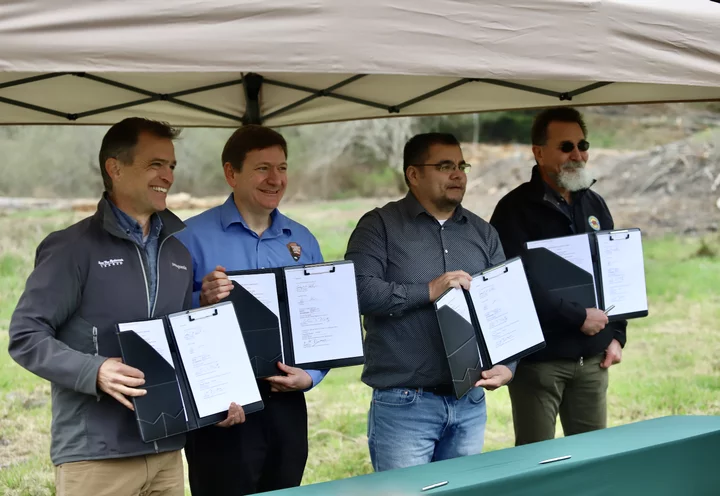
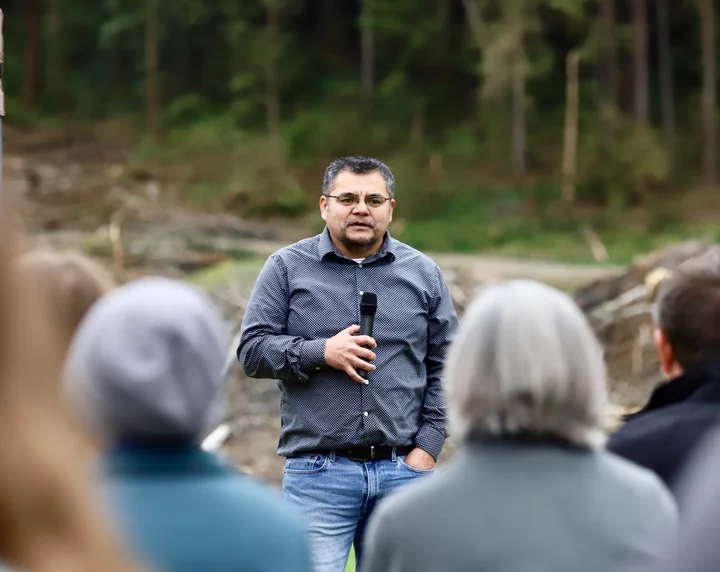

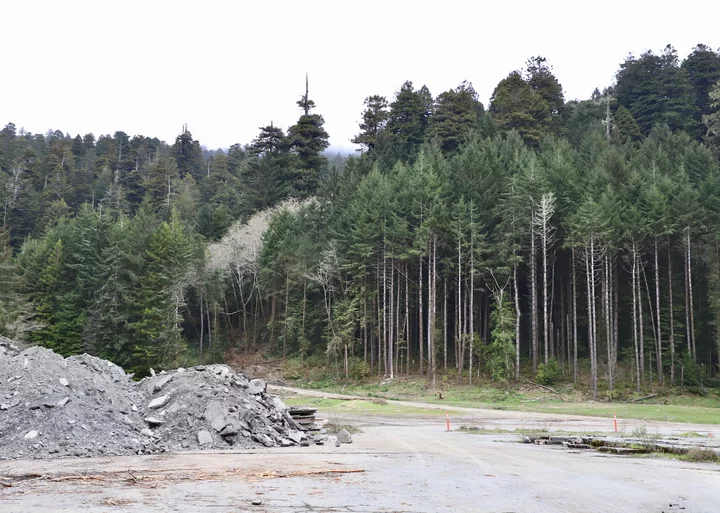
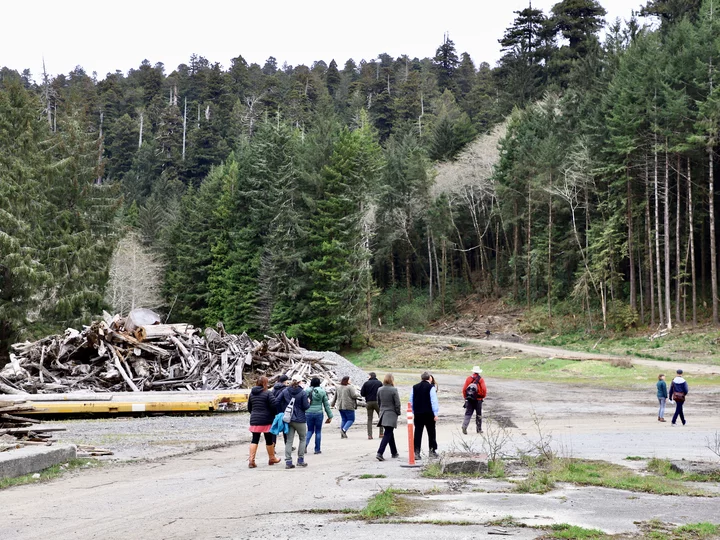
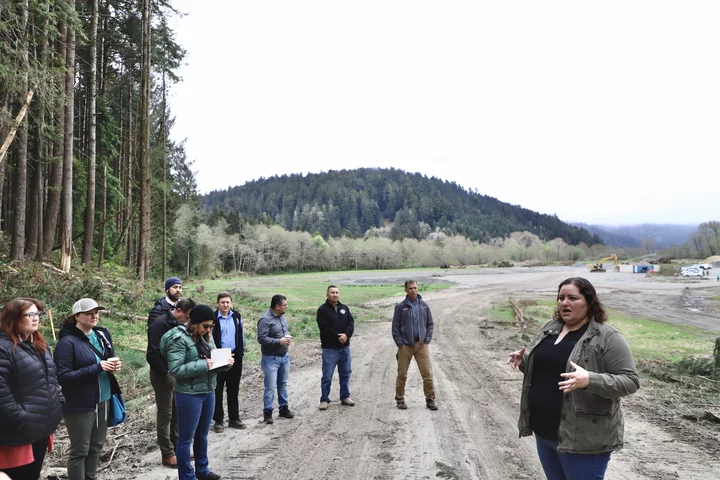
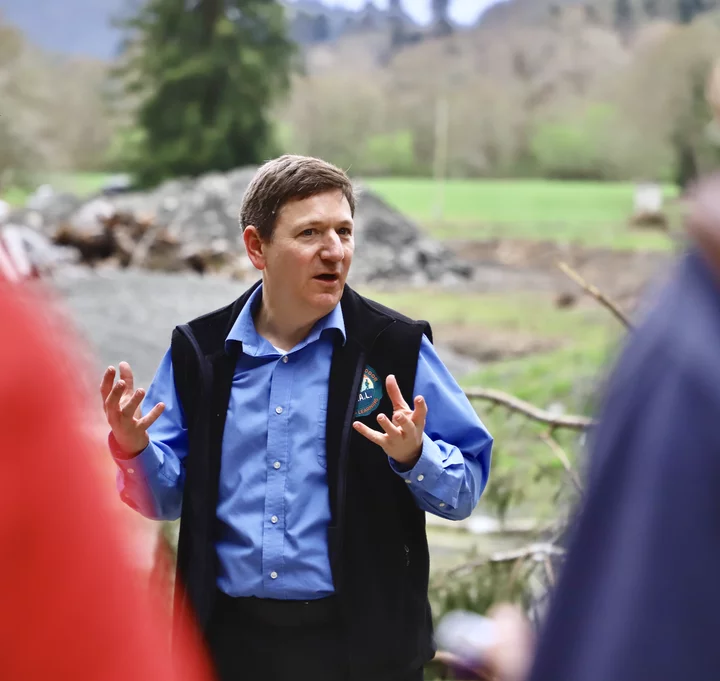
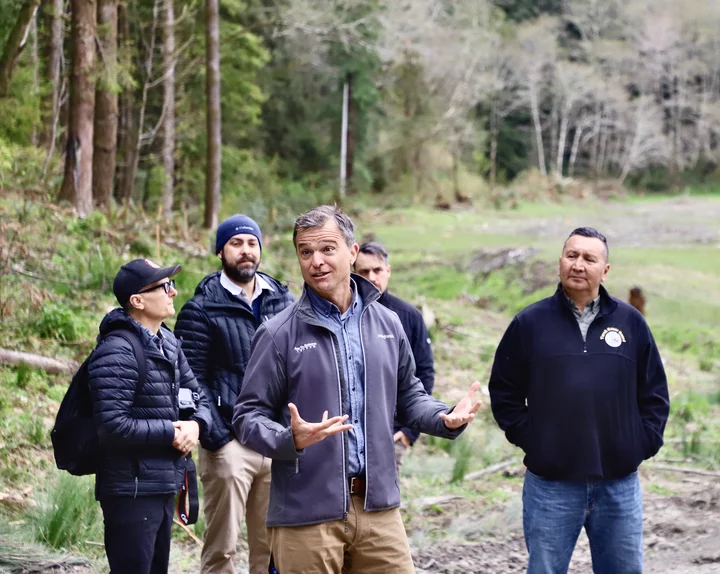
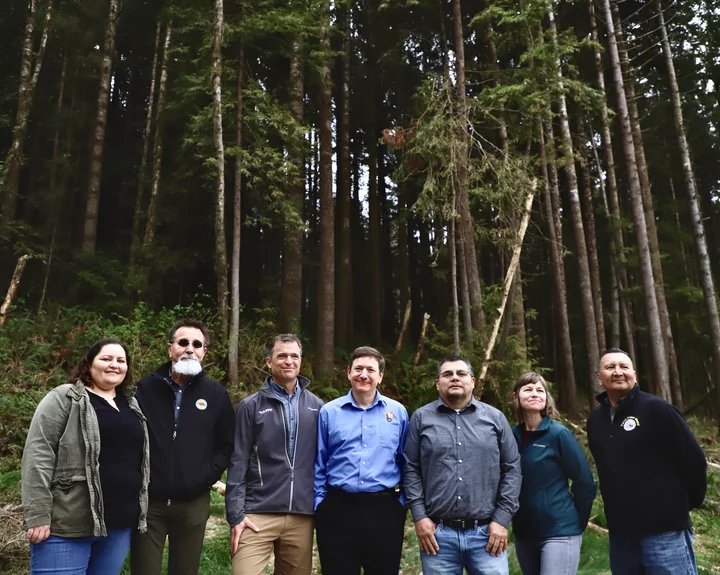
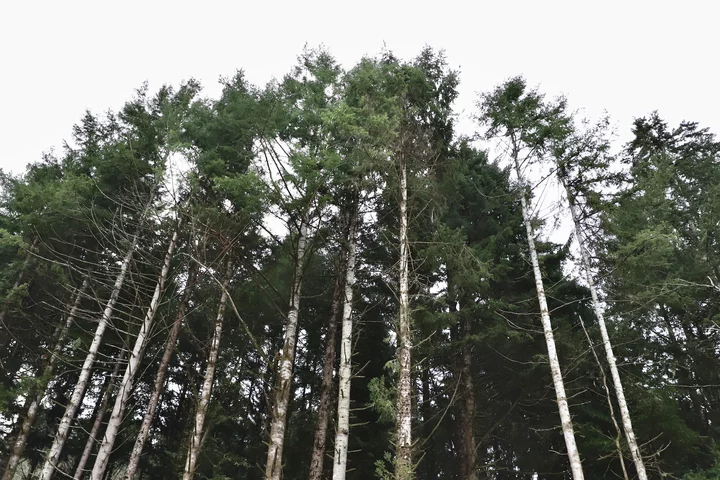
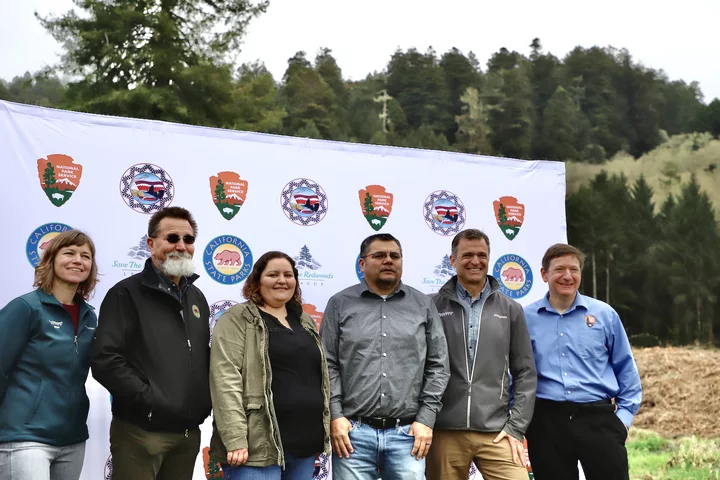
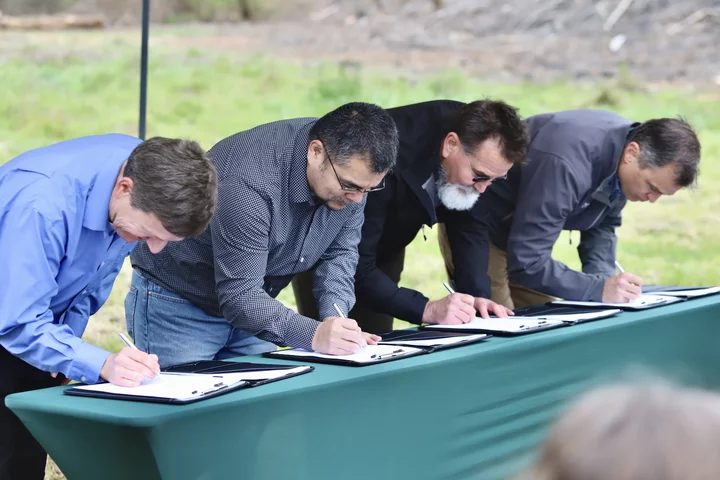

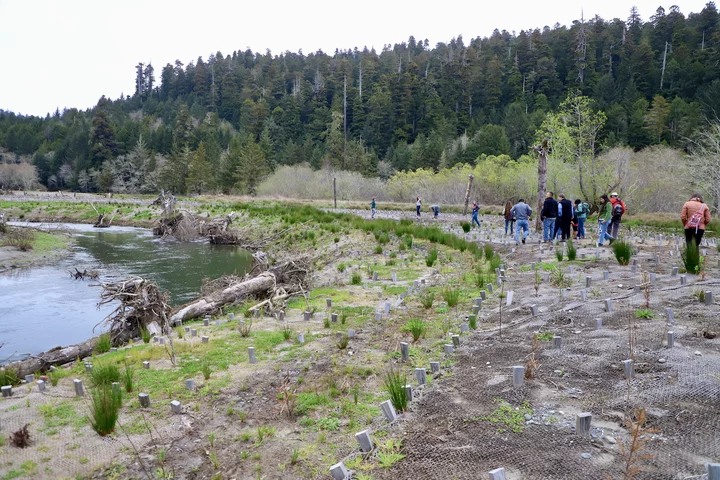
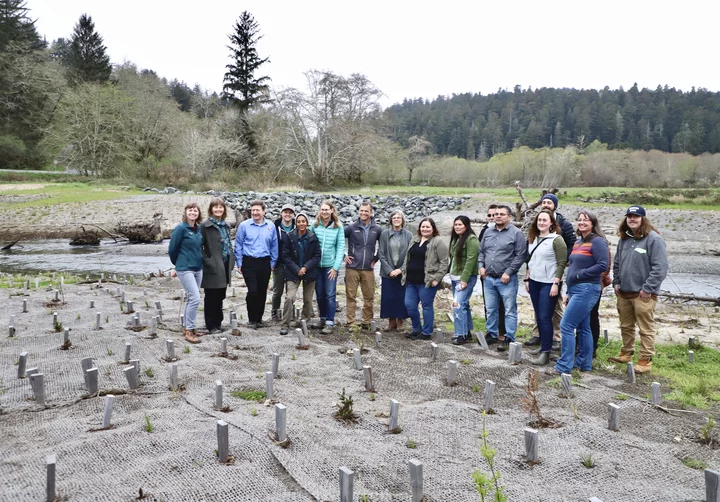
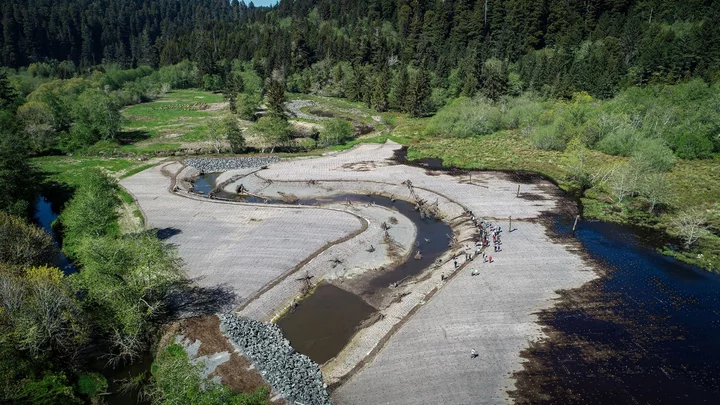
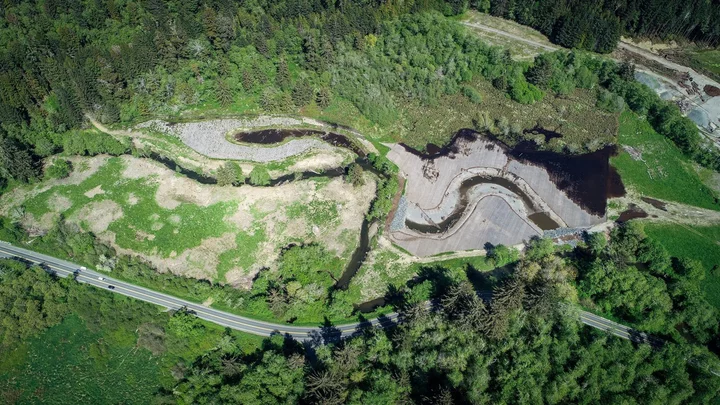
CLICK TO MANAGE